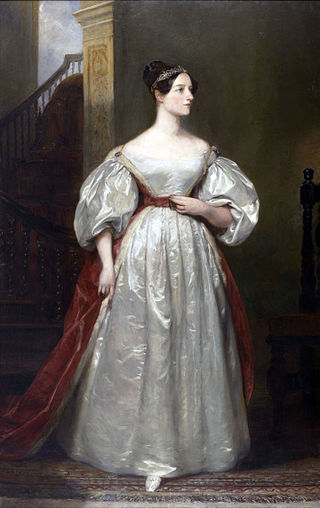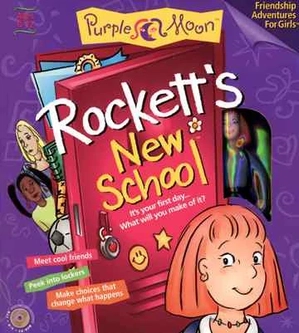Telepresence refers to a set of technologies which allow a person to feel as if they were present, to give the appearance or effect of being present via telerobotics, at a place other than their true location.

Scott Fisher is the Professor and Founding Chair of the Interactive Media Division in the USC School of Cinematic Arts at the University of Southern California, and Director of the Mobile and Environmental Media Lab there. He is an artist and technologist who has worked extensively on virtual reality, including pioneering work at NASA, Atari Research Labs, MIT's Architecture Machine Group and Keio University.

Women in computing were among the first programmers in the early 20th century, and contributed substantially to the industry. As technology and practices altered, the role of women as programmers has changed, and the recorded history of the field has downplayed their achievements. Since the 18th century, women have developed scientific computations, including Nicole-Reine Lepaute's prediction of Halley's Comet, and Maria Mitchell's computation of the motion of Venus.

T. L. Taylor is an American sociologist and professor. Taylor specialises in researching the culture of gaming and online communities, in particular, esports, live-streaming, and MMOGs such as EverQuest and World of Warcraft.

Rebecca Allen is an internationally recognized digital artist inspired by the aesthetics of motion, the study of perception and behavior and the potential of advanced technology. Her artwork, which spans four decades and takes the form of experimental video, large-scale performances, live simulations and virtual and augmented reality art installations, addresses issues of gender, identity and what it means to be human as technology redefines our sense of reality.

Virtual art is a term for the virtualization of art, made with the technical media developed at the end of the 1980s. These include human-machine interfaces such as visualization casks, stereoscopic spectacles and screens, digital painting and sculpture, generators of three-dimensional sound, data gloves, data clothes, position sensors, tactile and power feed-back systems, etc. As virtual art covers such a wide array of mediums it is a catch-all term for specific focuses within it. Much contemporary art has become, in Frank Popper's terms, virtualized.
Gender HCI is a subfield of human-computer interaction that focuses on the design and evaluation of interactive systems for humans. The specific emphasis in gender HCI is on variations in how people of different genders interact with computers.

Immersion into virtual reality (VR) is the perception of being physically present in a non-physical world. The perception is created by surrounding the user of the VR system in images, sound or other stimuli that provide an engrossing total environment.
Purple Moon was an American developer of girls' video games based in Mountain View, California. Its games were targeted at girls between the ages of 8 and 14. The company was founded by Brenda Laurel and others, and supported by Interval Research. They debuted their first two games, Rockett's New School and Secret Paths in the Forest, in 1997. Both games were more or less visual novels and encouraged values like friendship and decision making. Purple Moon's games were part of a larger girl games movement in the 1990s, initiated largely by the surprise success of Mattel's 1996 CD-ROM game Barbie Fashion Designer.

Mary Flanagan is an American artist, author, educator, and designer. She pioneered the field of game research with her ideas on critical play and has written several books. She is the founding director of the research laboratory and design studio Tiltfactor Lab and the CEO of the board game company Resonym. Flanagan's work as an artist has been shown around the world and won the Award of Distinction at Prix Ars Electronica in 2018.

Justine M. Cassell is an American professor and researcher interested in human-human conversation, human-computer interaction, and storytelling. Since August 2010, she has been on the faculty of the Carnegie Mellon Human Computer Interaction Institute (HCII) and the Language Technologies Institute, with courtesy appointments in Psychology, and the Center for Neural Bases of Cognition. Cassell has served as the chair of the HCII, as associate vice-provost, and as Associate Dean of Technology Strategy and Impact for the School of Computer Science. She currently divides her time between Carnegie Mellon, where she now holds the Dean's Professorship in Language Technologies, and PRAIRIE, the Paris Institute on Interdisciplinary Research in AI, where she also holds the position of senior researcher at Inria Paris.
Antoinette LaFarge is a new media artist and writer known for her work with mixed-reality performance and projects exploring the conjunction of visual art and fiction.

Diane Gromala is a Canada Research Chair and a Professor in the Simon Fraser University School of Interactive Arts and Technology. Her research works at the confluence of computer science, media art and design, and has focused on the cultural, visceral, and embodied implications of digital technologies, particularly in the realm of chronic pain.
Jessica Hammer is an assistant professor in the Human-Computer Interaction Institute at Carnegie Mellon University.

Barbie Fashion Designer is a dress-up computer game developed by Digital Domain and published by Mattel Media for Microsoft Windows and Mac OS in 1996. The game allows players to design clothing and style outfits. Players can then print off their designs and create clothing for their real-world Barbie dolls. Barbie Fashion Designer was the first commercially successful video game made for girls. After its success, many other girl games would be made, leading to the girls' games movement.

Rockett's New School is a 1997 girl-oriented video game developed by Silicon Valley-based Purple Moon. It was directed by Brenda Laurel.
Secret Paths in the Forest is a video game developed by Purple Moon. The game was designed to be episodic, and spawned sequels entitled "Secret Paths to Your Dreams" and "Secret Paths to the Sea”, which were released under Mattel after its 1999 acquisition of Purple Moon.
Starfire Soccer Challenge is a video game by Purple Moon, released in November 1998.
Ghislaine Boddington is a British artist, curator, presenter and director specialising in body responsive technologies, immersive experiences and collective embodiment, pioneering it as 'hyper-enhancement of the senses' and 'hyper-embodiment' since the late 80s.
Johanna Pirker is an Austrian computer scientist, educator, and game designer at Graz University of Technology and professor at Ludwig Maximilian University of Munich with a focus on games research, virtual reality and data science. Pirker was listed on the Forbes 30 under 30 Europe list in the category Science & Healthcare (2018) for her efforts in improving digital education with virtual reality environments and games. She holds a Ph.D. in Computer Science. Her dissertation was supervised by the Austrian e-learning expert Christian Gütl and MIT professor of physics John Winston Belcher. She is involved in various efforts to educate about the potential of video games. This also includes efforts to advocate the background and cultural aspect of video games. In 2020 she received the Käthe-Leichter Prize for her efforts for her initiatives in the field of diversity in engineering and in the games industry. In 2021 she received the Hedy Lamarr Prize.











